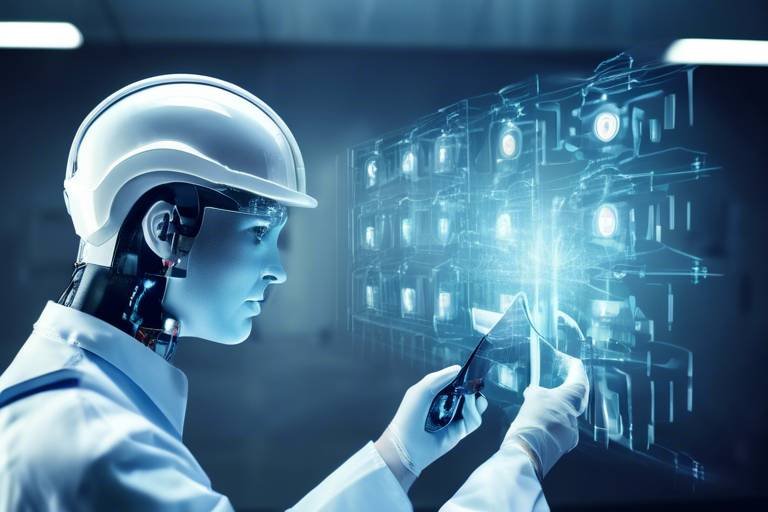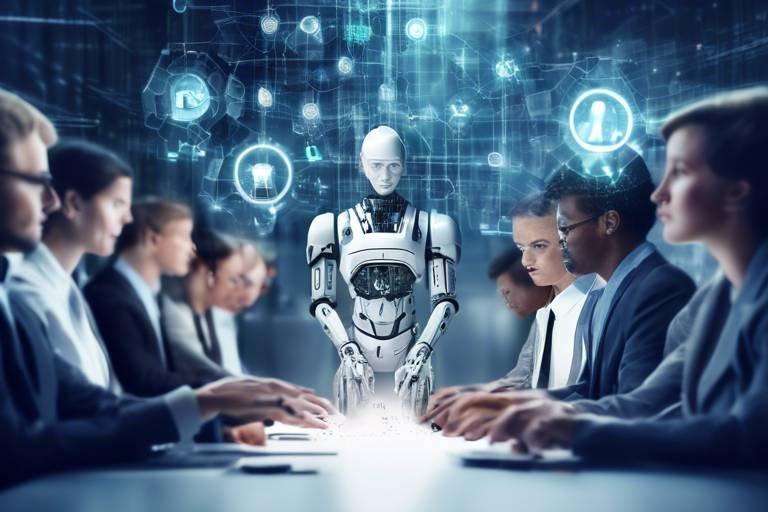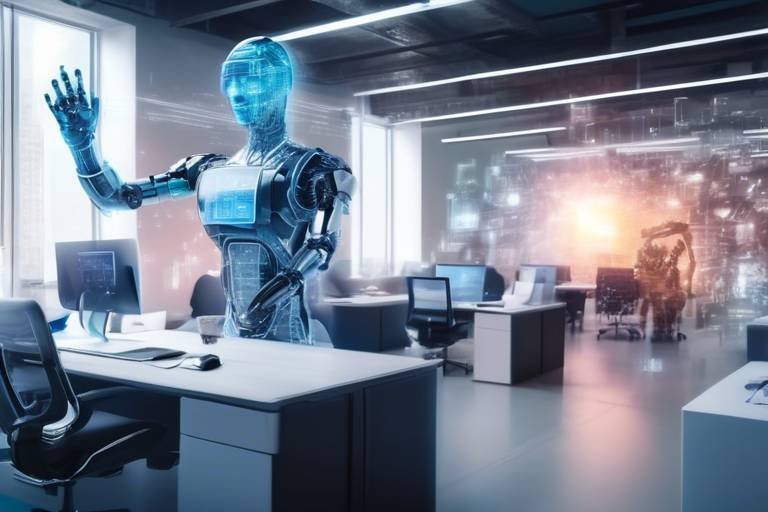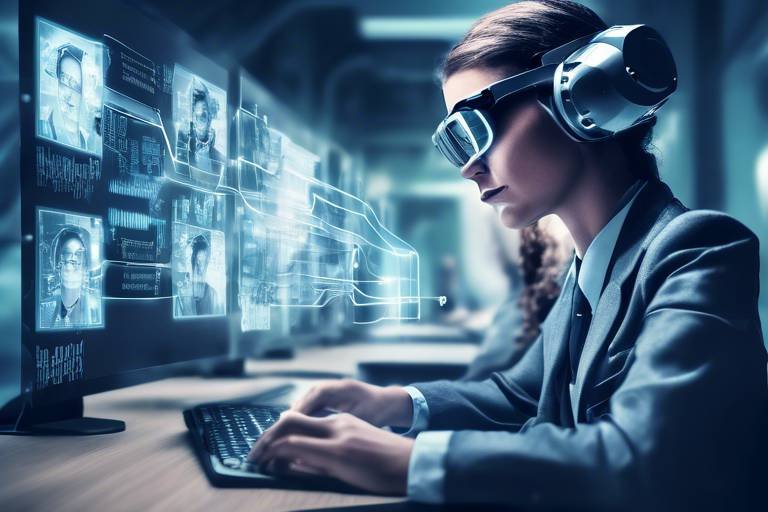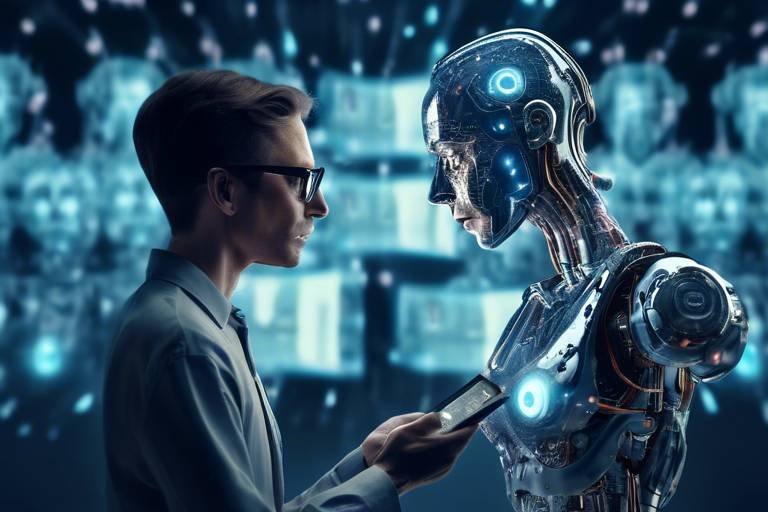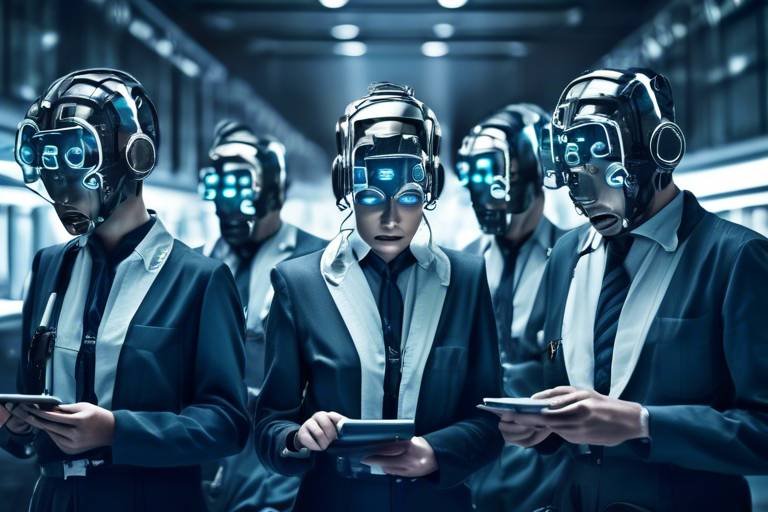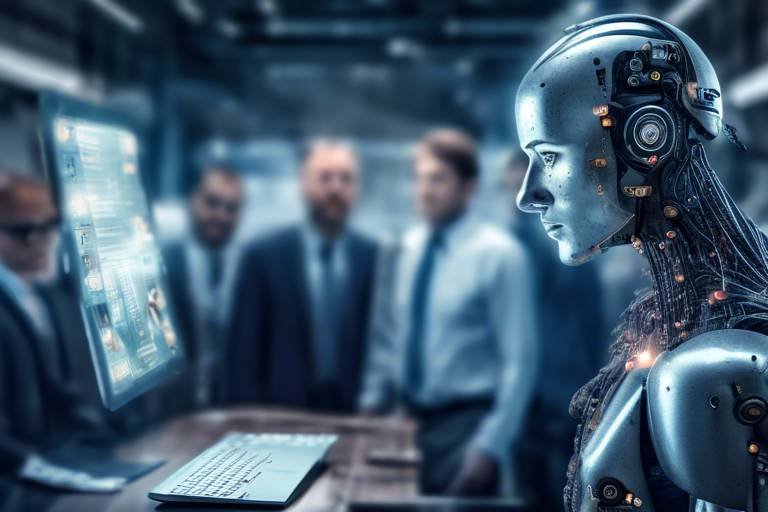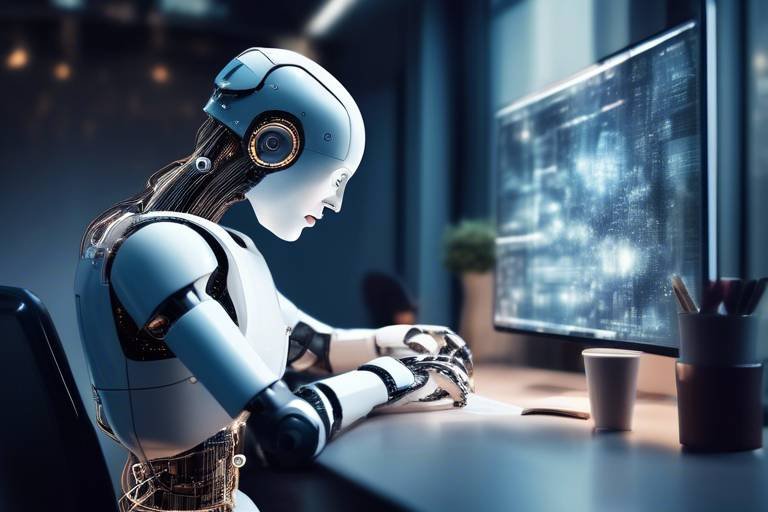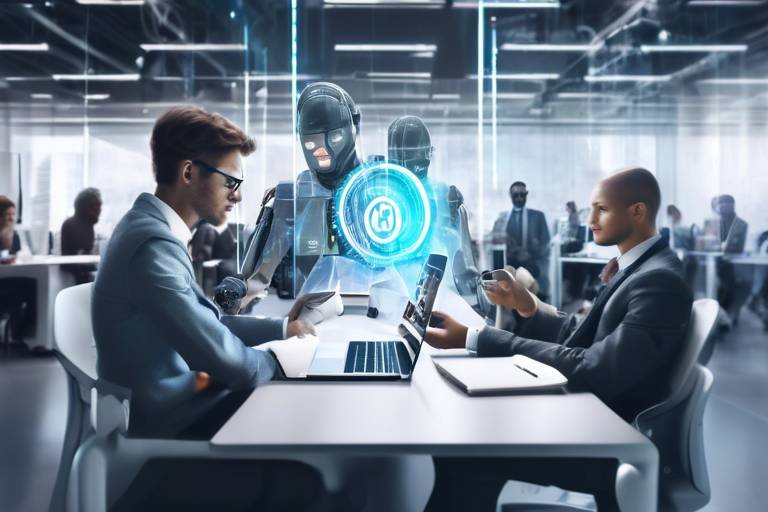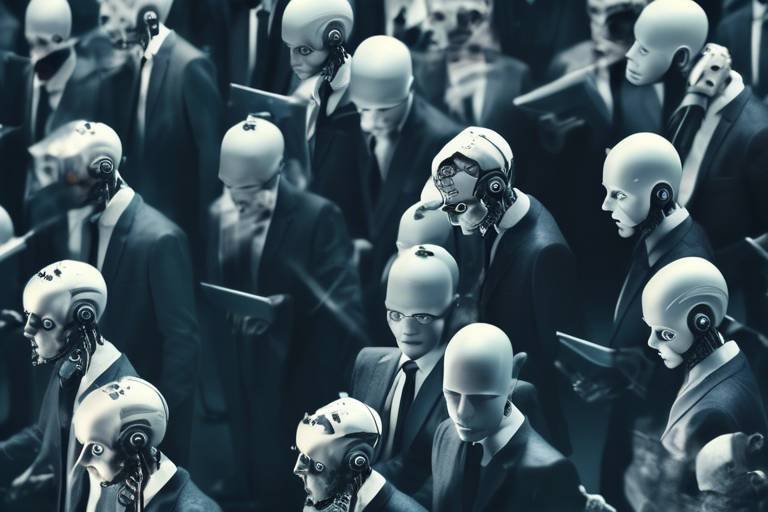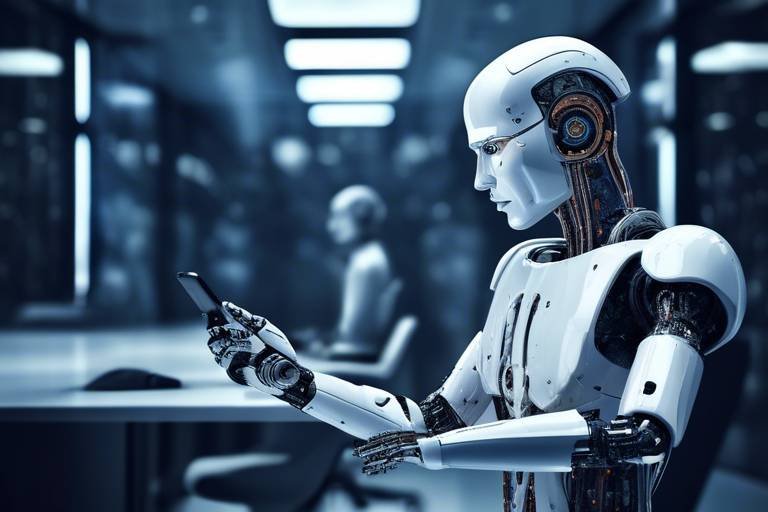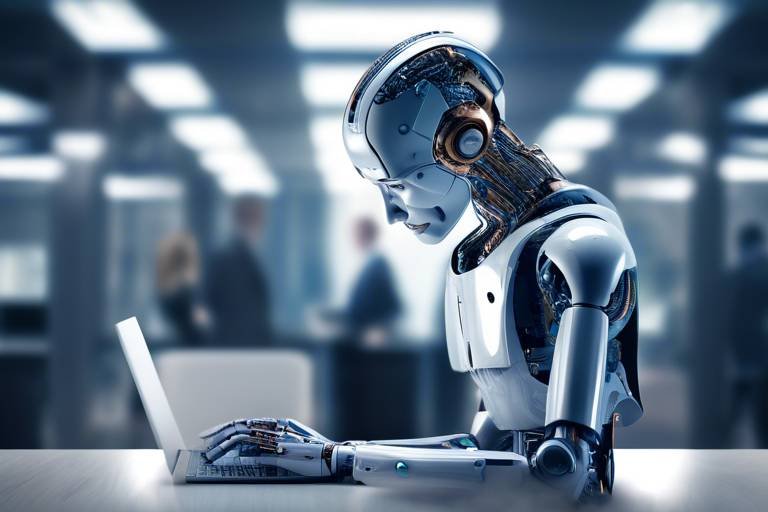Future Job Trends: Role of AI in Health and Safety at Work
In today's rapidly evolving workplace, the integration of artificial intelligence (AI) is not just a trend; it's a revolution. As we stand on the brink of a new era, it's fascinating to see how AI is reshaping job trends, particularly in the realm of health and safety. Imagine a workplace where potential hazards are predicted before they even occur, where employee wellness is monitored in real-time, and where training is tailored to individual needs. This is not a distant future; it’s happening now, and the implications are profound.
AI technologies are revolutionizing workplace safety protocols in ways we never thought possible. By harnessing the power of data analytics, AI can predict hazards, analyze trends, and improve emergency response systems. For instance, consider a manufacturing plant where AI systems analyze historical accident data to identify patterns and predict future incidents. This proactive approach not only enhances safety measures but also fosters a culture of awareness among employees. The result? A significant reduction in workplace accidents and a more secure environment for everyone.
Employers are increasingly adopting AI-driven health monitoring systems that track employee health metrics. These systems enable early detection of potential health issues, allowing for timely interventions. Think of it as having a personal health assistant that constantly monitors your well-being. Whether it's tracking heart rates, stress levels, or even sleep patterns, these systems foster a proactive approach to employee wellness. The more we know about our health, the better we can manage it, right?
Wearable devices equipped with AI algorithms are becoming a staple in many workplaces. These devices monitor physical activities and stress levels, providing real-time feedback to employees. Imagine wearing a smartwatch that alerts you when your stress levels spike or when you've been sitting too long. This immediate feedback not only enhances overall safety but also encourages employees to take charge of their health.
The integration of wearable technology in workplaces offers numerous benefits. Here are a few:
- Injury Prevention: By monitoring physical activities, wearables can alert employees to unsafe practices.
- Health Awareness: Real-time data helps employees understand their health better.
- Improved Productivity: Better health management leads to increased productivity.
Despite the advantages, implementing wearable technology poses challenges. Privacy concerns are paramount; employees may feel uncomfortable with constant monitoring. Additionally, data security issues arise, as sensitive health information must be protected. Finally, there’s the need for employee training to ensure that everyone understands how to use these devices effectively. It's a balancing act that organizations must navigate carefully.
AI is transforming risk assessment by utilizing predictive analytics to identify potential hazards. This allows organizations to implement preventive measures and reduce workplace incidents. Imagine a scenario where AI analyzes data from various sources—employee reports, equipment maintenance logs, and environmental conditions—to forecast risks before they manifest. This level of foresight can save lives and protect businesses from costly accidents.
AI-enhanced training programs offer personalized learning experiences, equipping employees with the skills to recognize and mitigate health and safety risks effectively. These programs adapt to individual learning styles and paces, making training more engaging and effective. No more one-size-fits-all training sessions; instead, each employee receives tailored content that speaks directly to their needs.
Virtual reality (VR) technology, powered by AI, provides immersive training experiences that simulate real-life scenarios. Picture employees practicing safety protocols in a controlled environment, where they can make mistakes without real-world consequences. This hands-on approach not only builds confidence but also ensures that employees are well-prepared for emergencies.
AI systems facilitate continuous learning by adapting training content based on employee performance and feedback. This ensures that safety training remains relevant and effective. If an employee struggles with a particular concept, the AI can provide additional resources or adjust the training module accordingly. It’s like having a personal tutor who knows exactly what you need to succeed.
As AI technology continues to evolve, its role in health and safety will expand. We're on the cusp of innovative solutions that will enhance workplace well-being and compliance. Imagine a future where AI not only predicts accidents but also suggests improvements to workplace design and processes. The possibilities are endless, and the potential benefits for employees and employers alike are staggering.
- How does AI improve workplace safety? AI analyzes data to predict hazards, enhancing safety protocols and reducing incidents.
- What are wearable technologies? Wearable devices monitor health metrics, providing real-time feedback to promote wellness.
- Are there privacy concerns with AI in the workplace? Yes, employee monitoring raises privacy and data security issues that organizations must address.
- What is VR training? Virtual reality training immerses employees in simulated environments to practice safety protocols.

The Impact of AI on Workplace Safety
Artificial Intelligence (AI) is not just a buzzword; it's a transformative force reshaping how we think about workplace safety. Imagine a world where machines can predict hazards before they occur, analyze vast amounts of data in seconds, and even improve emergency response systems. Sounds futuristic, right? Well, it's happening now! AI technologies are revolutionizing safety protocols, making workplaces not only safer but also more efficient.
One of the most significant impacts of AI on workplace safety is its ability to predict potential hazards. Through advanced algorithms and machine learning, AI systems can analyze historical data and identify patterns that humans might overlook. For instance, if a factory has a history of accidents related to a specific machine, AI can flag this information, prompting management to take preventive actions. This proactive approach can drastically reduce the number of workplace incidents, saving lives and resources.
Moreover, AI enhances the emergency response systems within organizations. In the event of an accident, AI can quickly assess the situation, determine the best course of action, and even guide emergency responders to the scene. This swift response can mean the difference between life and death, showcasing just how critical AI is in modern safety practices.
Additionally, AI's data analysis capabilities allow for continuous monitoring of workplace environments. Sensors and cameras equipped with AI can detect unsafe conditions, such as gas leaks or equipment malfunctions, and alert employees in real-time. This immediate feedback creates a culture of safety, where employees are constantly aware of their surroundings and can act swiftly to mitigate risks.
Let's break down some key benefits of AI in workplace safety:
- Enhanced Risk Identification: AI systems can analyze data from various sources to identify risks that human assessments might miss.
- Real-Time Monitoring: Continuous surveillance of workplace conditions helps in immediate hazard detection.
- Improved Compliance: AI can ensure that safety protocols are followed consistently, reducing the likelihood of regulatory violations.
In conclusion, the impact of AI on workplace safety is profound and far-reaching. As these technologies continue to evolve, we can expect even more innovative solutions that will not only enhance safety but also improve overall workplace efficiency. By embracing AI, organizations can create a safer environment for their employees and foster a culture of well-being that prioritizes health and safety.

AI-Driven Health Monitoring Systems
In today's fast-paced work environment, the health and well-being of employees are more critical than ever. With the rise of , employers now have powerful tools at their disposal to keep track of employee health metrics. These systems not only help in early detection of potential health issues but also foster a culture of wellness within the workplace. Imagine a scenario where a simple wearable device can alert both the employee and the employer about rising stress levels or fatigue, allowing for timely interventions. This proactive approach is changing the game in workplace health management.
AI technologies analyze vast amounts of data collected from various sources, such as wearable devices, health apps, and even environmental sensors. By employing sophisticated algorithms, these systems can identify patterns and trends related to employee health. For instance, if a significant number of employees report increased fatigue during a particular time of day, the system can flag this as a potential issue. This kind of insight not only helps in addressing immediate health concerns but also informs long-term health strategies.
One of the most exciting aspects of AI-driven health monitoring is its ability to promote a proactive approach to employee wellness. Instead of waiting for employees to report issues, employers can take initiative. Here’s how:
- Real-time Monitoring: Continuous tracking of health metrics allows employers to respond quickly to any signs of distress.
- Personalized Health Plans: With detailed data analysis, employers can tailor wellness programs to meet the specific needs of their workforce.
- Enhanced Communication: AI systems facilitate better communication between employees and management regarding health concerns, fostering a supportive work environment.
However, while the benefits are substantial, the implementation of AI-driven health monitoring systems is not without its challenges. Concerns regarding data privacy and security are paramount. Employees may feel uneasy about their health data being collected and analyzed, leading to potential trust issues. Therefore, it is essential for organizations to establish clear policies on data use and ensure that employees are informed and comfortable with how their information is handled.
Moreover, successful implementation requires adequate training for both employees and management. Understanding how to interpret the data and make informed decisions based on it is crucial for maximizing the benefits of AI-driven health monitoring systems. This is where the role of continuous education and support comes into play, ensuring that everyone is on the same page regarding health and safety protocols.
In conclusion, AI-driven health monitoring systems are revolutionizing workplace wellness by offering a proactive approach to health management. By leveraging data and technology, organizations can create safer, healthier work environments that not only enhance employee well-being but also improve overall productivity. As we move forward, embracing these innovations will be vital for companies looking to stay ahead in the competitive landscape.
Q1: What are AI-driven health monitoring systems?
AI-driven health monitoring systems utilize artificial intelligence to track and analyze employee health metrics, helping organizations detect potential health issues before they escalate.
Q2: How do these systems promote employee wellness?
By providing real-time data and insights, these systems enable employers to implement timely interventions and personalized health plans, fostering a culture of wellness.
Q3: What challenges do organizations face when implementing these systems?
Challenges include data privacy concerns, the need for employee training, and ensuring that health data is used responsibly and ethically.

Wearable Technology in the Workplace
In today's fast-paced work environment, wearable technology has emerged as a game-changer, revolutionizing how we approach health and safety. Imagine a world where your smartwatch not only tracks your steps but also monitors your stress levels and alerts you to potential hazards in real-time. This is not just a futuristic dream; it’s happening right now! Wearable devices equipped with advanced AI algorithms are transforming workplaces, making them safer and more efficient.
These devices offer a wide array of functionalities that can significantly enhance employee safety. For instance, they can monitor physical activities, ensuring that workers are not overexerting themselves, which is crucial in physically demanding jobs. Additionally, they can track vital signs such as heart rate, oxygen levels, and even body temperature, alerting employees and management to any concerning changes. This proactive approach enables early intervention, which can be the difference between a minor issue and a serious health crisis.
Moreover, the integration of wearable technology fosters a culture of health awareness. Employees become more conscious of their well-being, leading to better lifestyle choices. They can receive real-time feedback on their physical condition, allowing them to make informed decisions about their health. For example, if a wearable device detects elevated stress levels, it can prompt the user to take a break or engage in a relaxation technique, ultimately improving their productivity and job satisfaction.
However, it's essential to recognize that implementing wearable technology isn't without its challenges. Companies must navigate concerns related to privacy and data security. Employees may feel apprehensive about their health data being monitored and stored, raising questions about who has access to this information and how it will be used. To address these concerns, organizations must prioritize transparency and establish clear policies regarding data handling.
Additionally, there’s a need for comprehensive employee training. Workers must understand how to use these devices effectively and the benefits they offer. Without proper training, the potential of wearable technology may not be fully realized, and employees might resist adopting these innovations. Therefore, companies should invest in training programs that educate employees about the technology, its advantages, and how it can enhance their safety and well-being.
In conclusion, wearable technology in the workplace is not just a trend; it is a significant leap towards creating safer and healthier work environments. As organizations continue to embrace this technology, they will not only improve employee well-being but also foster a culture of safety that can lead to increased productivity and job satisfaction.
- What types of wearable technology are commonly used in workplaces?
Common types include smartwatches, fitness trackers, and specialized devices designed for specific industries, such as helmets with built-in sensors for construction workers.
- How does wearable technology improve workplace safety?
Wearable technology enhances safety by monitoring health metrics, detecting hazardous conditions, and providing real-time feedback to employees.
- Are there privacy concerns associated with wearable technology?
Yes, privacy concerns exist, particularly regarding how health data is collected, stored, and used. Employers must ensure transparency and data protection.
- What should companies consider before implementing wearable technology?
Companies should consider employee training, data privacy policies, and the specific needs of their workforce before implementing wearable technology.

Benefits of Wearable Tech
Wearable technology in the workplace is not just about keeping up with the latest gadgets; it’s about enhancing the overall safety and productivity of employees. Imagine a world where your watch not only tells time but also monitors your health and alerts you to potential dangers in real-time. This is the reality that wearable tech brings to the workplace. By integrating these devices into daily routines, employers can foster a culture of health and safety that benefits everyone involved.
One of the most significant benefits of wearable technology is its capability to prevent injuries. For instance, devices can track physical exertion levels and alert employees when they are overexerting themselves, thus reducing the risk of strain-related injuries. Additionally, wearables can monitor environmental conditions, such as temperature and air quality, ensuring that employees are not exposed to hazardous situations.
Moreover, these devices promote health awareness among employees. With real-time feedback on metrics like heart rate, stress levels, and activity patterns, employees can become more conscious of their health. This awareness often leads to healthier lifestyle choices, which can significantly reduce absenteeism and healthcare costs for employers. In fact, studies have shown that organizations that encourage health-focused technology see a notable increase in employee engagement and satisfaction.
Another advantage is the potential for improved productivity. When employees feel better physically and mentally, they tend to perform better at their tasks. Wearable technology can facilitate this by providing insights that help employees manage their workload more effectively. For example, if a device detects signs of fatigue, it can suggest taking a break or engaging in a quick mindfulness exercise, leading to a refreshed and more focused workforce.
However, the benefits of wearable tech extend beyond individual health. Organizations can leverage the data collected from these devices to make informed decisions about workplace safety protocols. By analyzing trends and patterns, employers can identify areas for improvement, ensuring that safety measures evolve alongside the workforce's needs.
In summary, the integration of wearable technology in the workplace presents numerous benefits:
- Injury Prevention: Real-time monitoring reduces the risk of physical strain.
- Health Awareness: Encourages employees to adopt healthier lifestyles.
- Improved Productivity: Helps manage workload and reduces fatigue.
- Data-Driven Safety Measures: Enables informed decisions for a safer work environment.
As we move forward, embracing wearable technology not only enhances individual well-being but also cultivates a safer and more productive workplace culture. The future is bright for organizations willing to invest in these innovative solutions.
- What types of wearable technology are used in workplaces?
Common types include smartwatches, fitness trackers, and specialized health monitoring devices. - How does wearable tech improve workplace safety?
Wearable devices can monitor health metrics and environmental conditions, providing alerts and data to prevent injuries. - Are there privacy concerns with using wearable technology?
Yes, there are concerns regarding data security and employee privacy, which organizations must address when implementing these technologies. - Can wearable tech help reduce healthcare costs?
By promoting health awareness and preventing injuries, wearable tech can lead to reduced absenteeism and lower healthcare expenses.

Challenges of Implementing Wearables
While the integration of wearable technology in the workplace brings a multitude of benefits, it's not without its challenges. One of the primary concerns revolves around privacy. Employees may feel uncomfortable with their health data being monitored continuously, leading to a sense of surveillance rather than support. This concern can create an atmosphere of mistrust, which is detrimental to workplace morale.
Another significant challenge is data security. With the collection of sensitive health information, organizations must ensure that robust security measures are in place to protect this data from breaches. A single incident of data leakage can not only harm individual employees but can also tarnish the organization's reputation.
Moreover, there is the issue of employee training. For wearables to be effective, employees need to be adequately trained on how to use these devices. This includes understanding the technology, interpreting the data, and knowing how to respond to alerts. If employees are not properly educated, the benefits of wearables can be significantly undermined.
Additionally, the cost of implementation can be a hurdle for many organizations, especially smaller businesses. Investing in wearable technology, along with the necessary infrastructure and training, can be a substantial financial burden. Companies must weigh the costs against the potential benefits to determine if this investment is worthwhile.
Finally, there is the challenge of employee acceptance. Not every employee will be enthusiastic about adopting new technology. Some may resist change, fearing that wearables might lead to stricter monitoring or increased pressure to perform. Therefore, fostering a culture of acceptance and understanding is critical to the successful implementation of wearable technology in the workplace.
In summary, while the benefits of wearable technology are compelling, organizations must navigate a complex landscape of challenges, including privacy concerns, data security, training needs, implementation costs, and employee acceptance. Addressing these challenges head-on will be essential for maximizing the potential of wearables in enhancing workplace health and safety.
- What types of wearables are commonly used in workplaces? Wearable devices like fitness trackers, smartwatches, and health monitoring bands are commonly used to monitor employee health and activity.
- How can companies ensure data security with wearables? Companies should implement strong encryption, access controls, and regular security audits to protect sensitive health data.
- What are the benefits of using wearables in the workplace? Wearables can enhance employee health awareness, improve safety protocols, and lead to increased productivity through better health management.
- How can companies encourage employee acceptance of wearable technology? Providing clear communication about the benefits, involving employees in the implementation process, and ensuring privacy can help foster acceptance.

AI in Risk Assessment
Artificial Intelligence (AI) is revolutionizing the way organizations approach risk assessment in the workplace. Traditionally, risk assessments were often time-consuming and relied heavily on manual input, which could lead to human error and oversight. However, with the advent of AI, businesses can now harness the power of predictive analytics to identify potential hazards before they manifest into real problems. This proactive approach not only enhances safety but also contributes to a culture of continuous improvement.
Imagine a workplace where risks are not just identified after an incident occurs, but anticipated and mitigated beforehand. AI algorithms analyze vast amounts of data—from historical incident reports to real-time sensor data—allowing companies to pinpoint patterns and trends that may indicate an impending risk. For instance, if a manufacturing plant notices a spike in equipment malfunctions, AI can correlate this with specific environmental conditions or operator behaviors, enabling management to take preemptive action.
Furthermore, AI in risk assessment can significantly reduce the time and resources spent on compliance. By automating the data collection and analysis processes, organizations can streamline their safety protocols, ensuring they meet regulatory requirements without the hassle of manual documentation. This not only saves time but also reduces the risk of non-compliance penalties, which can be financially devastating.
To illustrate the impact of AI in risk assessment, consider the following table that highlights key benefits:
| Benefit | Description |
|---|---|
| Proactive Risk Management | AI detects potential hazards before they escalate, allowing for timely interventions. |
| Data-Driven Decisions | Organizations can make informed decisions based on comprehensive data analysis. |
| Enhanced Compliance | Automated processes ensure adherence to safety regulations and standards. |
| Resource Efficiency | Reduces the time and manpower needed for traditional risk assessment methods. |
However, as with any technology, there are challenges to implementing AI in risk assessment. Organizations must ensure they have the right infrastructure and expertise to manage AI systems effectively. Additionally, there is a need for continuous training and adaptation of AI models to keep up with evolving workplace environments and risks.
In conclusion, the integration of AI into risk assessment represents a significant leap forward in workplace safety. By leveraging data and predictive analytics, organizations can not only enhance their safety protocols but also foster a culture of proactive risk management. As we move forward, embracing AI technology will be essential for businesses aiming to create safer and more efficient work environments.
- What is AI in risk assessment? AI in risk assessment refers to the use of artificial intelligence technologies to identify, analyze, and mitigate potential risks in the workplace.
- How does AI improve workplace safety? AI improves workplace safety by predicting potential hazards, analyzing data for trends, and enabling proactive risk management.
- What are the challenges of implementing AI for risk assessment? Challenges include the need for proper infrastructure, data management, continuous training, and addressing privacy concerns.
- Can AI replace human judgment in risk assessments? While AI can enhance risk assessments, human judgment is still crucial for interpreting data and making informed decisions.

AI-Powered Training Programs
As we venture into the future, the role of artificial intelligence in workplace training is becoming increasingly significant. AI-powered training programs are not just a trend; they are a transformative approach that reshapes how employees learn and adapt to new safety protocols. Imagine a world where every employee receives personalized training tailored to their specific needs and learning pace. Sounds futuristic, right? Well, it’s happening now!
These advanced programs leverage data analytics and machine learning algorithms to assess an employee’s current skill level and identify areas for improvement. By analyzing performance metrics, AI can create customized training modules that focus on the employee’s weaknesses while reinforcing their strengths. This means no more one-size-fits-all training sessions that leave employees feeling overwhelmed or underprepared. Instead, training becomes a dynamic experience, allowing employees to engage with the material in a way that resonates with them.
Furthermore, AI-driven training programs can adapt to the changing landscape of workplace safety. As new risks emerge, these systems can update training content in real-time, ensuring that employees are always equipped with the most relevant information. This adaptability is crucial in maintaining a safe work environment, as it allows organizations to stay ahead of potential hazards. Additionally, the use of AI in training can significantly reduce the time and resources spent on traditional training methods, ultimately leading to enhanced productivity.
One of the most exciting developments in AI-powered training is the integration of virtual reality (VR). Imagine stepping into a virtual world where you can practice emergency protocols without any real-world consequences. VR technology, enhanced by AI, provides immersive training experiences that simulate real-life scenarios. Employees can practice everything from fire drills to equipment handling in a safe, controlled environment. This not only boosts confidence but also ensures that when faced with actual emergencies, employees know exactly how to respond.
To illustrate the effectiveness of AI-powered training programs, let’s take a look at some key benefits:
| Benefit | Description |
|---|---|
| Personalization | Training is tailored to individual learning styles and paces. |
| Real-Time Updates | Training content evolves with the workplace, ensuring relevance. |
| Cost-Effectiveness | Reduces the need for extensive resources in traditional training. |
| Immersive Learning | VR technology provides realistic training experiences. |
However, while the benefits are clear, implementing AI-powered training programs also comes with challenges. Organizations must ensure that employees are comfortable with the technology and provide adequate training on how to use these new systems effectively. Moreover, there are concerns regarding data privacy and security, as sensitive employee information is often collected and analyzed. Addressing these challenges is essential to fully harness the potential of AI in training.
In conclusion, AI-powered training programs represent a significant leap forward in workplace safety education. By providing personalized, adaptable, and immersive learning experiences, they not only enhance employee engagement but also foster a culture of safety and preparedness. As we continue to embrace these technologies, the future of training in health and safety looks brighter than ever!

Virtual Reality Training
Imagine stepping into a world where you can practice safety protocols without any real-world risks. Virtual Reality (VR) training is making this a reality, quite literally! By immersing employees in lifelike scenarios, VR training allows them to experience potential hazards and learn how to react appropriately without the fear of actual consequences. This innovative approach not only enhances learning but also builds confidence in handling emergency situations.
One of the standout features of VR training is its ability to simulate a variety of environments. Whether it's a construction site, a manufacturing floor, or even a healthcare facility, VR can create realistic settings that reflect the specific challenges employees may face. This tailored experience ensures that training is relevant and engaging, making it easier for employees to retain information and apply it in real-life situations.
Furthermore, VR training offers several key advantages:
- Enhanced Engagement: The immersive nature of VR captures attention and keeps employees engaged, making the learning process more enjoyable.
- Immediate Feedback: Participants receive real-time feedback on their actions, allowing them to understand mistakes and correct them instantly.
- Safe Learning Environment: Employees can practice high-risk procedures without the danger of injury or damage to equipment.
- Cost-Effective: Although initial setup costs may be high, VR training can save money in the long run by reducing accident rates and minimizing downtime.
However, like any technology, VR training is not without its challenges. Implementing such a system requires investment in both hardware and software, as well as ongoing maintenance. Additionally, organizations must ensure that employees are comfortable using VR technology and provide adequate training on how to navigate these virtual environments.
Despite these hurdles, the potential of VR training in enhancing workplace safety is undeniable. As more companies recognize the benefits of immersive learning experiences, we can expect to see a surge in the adoption of VR technology across various industries. This shift not only promises to improve safety outcomes but also fosters a culture of continuous learning and adaptation in the workplace.
- What is Virtual Reality Training?
Virtual Reality Training is an immersive learning experience that simulates real-life scenarios, allowing employees to practice safety protocols in a controlled environment. - How does VR training improve safety?
By providing a safe space to practice emergency responses, VR training helps employees build confidence and competence in handling potential hazards. - What are the costs associated with implementing VR training?
Initial costs can be high due to the need for specialized equipment and software, but the long-term savings from reduced accidents can outweigh these expenses. - Can VR training be customized for different industries?
Absolutely! VR training can be tailored to fit the specific needs and challenges of various industries, from healthcare to construction.

Continuous Learning and Adaptation
In the fast-paced world of workplace safety, the concept of continuous learning and adaptation is not just a luxury; it's a necessity. As we integrate AI systems into our health and safety protocols, we open the door to a dynamic learning environment that evolves alongside our workforce. Imagine a workplace where training is not a one-time event, but an ongoing journey that adapts to the needs of each employee. This is the promise of AI-driven learning systems.
AI technologies can analyze an employee's performance in real time, identifying strengths and weaknesses. For instance, if an employee struggles with specific safety protocols, the AI can adjust the training materials accordingly, offering additional resources or simulations to help them improve. This personalized approach ensures that every worker receives the support they need to thrive in their roles. It's like having a personal coach who tailors their training regimen just for you!
Moreover, the integration of machine learning algorithms allows these systems to continuously evolve. As new safety regulations emerge or as new technologies are introduced, AI can update training content automatically. This means that employees are always learning the most relevant information, keeping them informed and prepared for any situation. The adaptability of these systems is crucial in industries where safety standards are constantly changing.
But how does this continuous learning translate into real-world benefits? Here are a few key advantages:
- Enhanced Safety Protocols: With ongoing training, employees are better equipped to recognize and respond to hazards, significantly reducing the likelihood of accidents.
- Increased Employee Engagement: Workers feel more valued when they see that their employers are investing in their development, leading to higher morale and retention rates.
- Data-Driven Insights: AI systems can provide valuable insights into training effectiveness, helping organizations refine their approaches and focus on areas that need improvement.
As we look to the future, the role of AI in fostering continuous learning and adaptation will only grow. Companies that embrace these technologies will not only enhance their health and safety measures but also create a culture of learning that empowers employees. In this way, AI becomes more than just a tool; it transforms into a partner in creating safer and more productive workplaces.
Q1: How does AI improve workplace safety?
AI improves workplace safety by predicting hazards, analyzing data, and enhancing emergency response systems, which leads to a safer work environment.
Q2: What are the benefits of wearable technology in the workplace?
Wearable technology offers benefits such as injury prevention, health awareness, and improved productivity through better health management.
Q3: What challenges do companies face when implementing AI-driven health monitoring systems?
Challenges include privacy concerns, data security issues, and the need for employee training to effectively use the technology.
Q4: How does continuous learning benefit employees?
Continuous learning keeps employees updated on safety protocols, enhances their skills, and increases engagement and job satisfaction.

The Future of AI in Health and Safety
As we look ahead, the role of artificial intelligence in health and safety is set to soar, transforming how organizations approach workplace well-being. The integration of AI technologies promises not just to enhance existing safety protocols but to fundamentally change the landscape of employee health management. Imagine a workplace where potential hazards are identified before they even occur, where health issues are detected early, and where training is tailored to each individual's needs. This is not just a dream; it's the future that AI is creating!
One of the most exciting aspects of this future is the emergence of smart workplaces. These environments will be equipped with advanced AI systems that continuously monitor various factors such as air quality, noise levels, and even employee stress indicators. By analyzing data in real-time, AI can alert management to potential risks, allowing for immediate interventions. This proactive approach is akin to having a personal safety assistant that never sleeps, always on the lookout for potential dangers.
Furthermore, the future of AI in health and safety will see a greater emphasis on personalization. With the help of machine learning algorithms, AI can assess individual employee health metrics and tailor wellness programs accordingly. For instance, if an employee is experiencing high stress levels, the AI system can recommend specific relaxation techniques or adjustments in workload. This level of customization not only empowers employees but also fosters a culture of well-being within the organization.
Additionally, we can expect to see a significant rise in the use of predictive analytics for risk assessment. AI can analyze vast amounts of historical data to identify patterns and predict future incidents. This capability allows organizations to implement preventative measures before issues arise, creating a safer work environment. For example, if data shows a spike in accidents during certain shifts, management can take proactive steps to address the underlying causes, such as increasing staffing or providing additional training.
As AI technology continues to evolve, its integration into training programs will become more sophisticated. Virtual reality (VR) training, powered by AI, will provide immersive experiences that simulate real-life scenarios. Employees will have the opportunity to practice safety protocols in a controlled environment, allowing them to build confidence and competence without the risks associated with real-world training. This hands-on approach not only enhances learning but also ensures that employees are better prepared for emergencies.
However, the journey towards a fully AI-integrated workplace will not be without challenges. Issues such as data privacy, security concerns, and the need for comprehensive training on new technologies will need to be addressed. Organizations must navigate these challenges carefully to ensure that the benefits of AI are realized without compromising employee trust or safety.
In conclusion, the future of AI in health and safety is bright and filled with potential. As organizations embrace these technologies, we can expect to see a transformation in workplace culture, where health and safety are prioritized through innovative solutions. The key to unlocking this future lies in collaboration—between technology developers, employers, and employees. Together, we can create safer, healthier workplaces that benefit everyone.
- How will AI improve workplace safety?
AI will enhance workplace safety by predicting hazards, analyzing data, and improving emergency responses, leading to safer environments. - What role do wearable technologies play in employee health?
Wearable technologies monitor health metrics, providing real-time feedback and encouraging proactive health management. - Are there privacy concerns with AI in the workplace?
Yes, implementing AI raises privacy and data security concerns that organizations must address through transparent policies. - How does AI personalize health and safety training?
AI uses employee performance data to tailor training programs, ensuring relevance and effectiveness in safety protocols.
Frequently Asked Questions
- How is AI improving workplace safety?
AI is revolutionizing workplace safety by predicting potential hazards, analyzing vast amounts of data, and enhancing emergency response systems. This proactive approach leads to safer work environments, reducing the likelihood of accidents and injuries.
- What are AI-driven health monitoring systems?
AI-driven health monitoring systems are technologies that track and analyze employee health metrics, allowing for early detection of health issues. By fostering a proactive approach to wellness, these systems help employers ensure their workforce remains healthy and productive.
- How do wearable technologies contribute to workplace safety?
Wearable technologies equipped with AI algorithms monitor physical activities and stress levels in real-time. This feedback helps employees manage their health better, leading to injury prevention and enhanced overall safety in the workplace.
- What challenges come with implementing wearable technology?
While wearable technology offers many benefits, challenges include privacy concerns, data security issues, and the necessity for employee training. Organizations must address these challenges to fully leverage the advantages of wearables.
- How does AI enhance risk assessment?
AI enhances risk assessment by utilizing predictive analytics to identify potential hazards before they occur. This allows organizations to implement preventive measures, ultimately reducing workplace incidents and fostering a safer work environment.
- What are AI-powered training programs?
AI-powered training programs provide personalized learning experiences for employees. These programs equip workers with the skills needed to recognize and mitigate health and safety risks effectively, ensuring they are well-prepared for real-life scenarios.
- How does virtual reality (VR) play a role in safety training?
Virtual reality technology, enhanced by AI, delivers immersive training experiences that simulate real-life situations. This allows employees to practice safety protocols in a controlled environment, boosting their confidence and preparedness.
- What is the future of AI in health and safety?
The future of AI in health and safety looks promising, with continuous advancements leading to innovative solutions that enhance workplace well-being. As technology evolves, its role in compliance and safety will expand, creating safer work environments for all.

